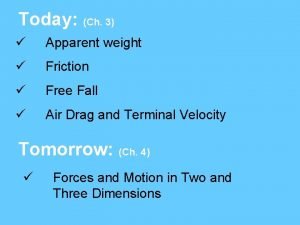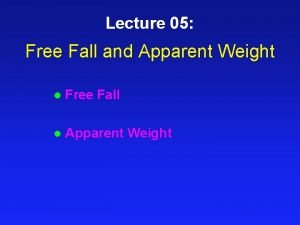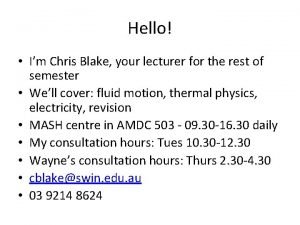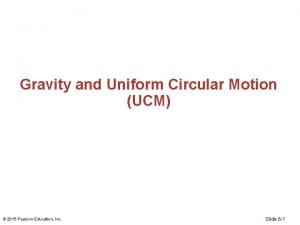WEIGHT AND APPARENT WEIGHT PES 1000 PHYSICS IN








- Slides: 8

WEIGHT AND APPARENT WEIGHT PES 1000 – PHYSICS IN EVERYDAY LIFE

WEIGHT AND APPARENT WEIGHT • Stationary weight: How do we sense weight while we stand motionless? • We sense the pressure from the normal force between our feet and the ground that is keeping us from falling through it. • Our muscles exert a certain amount of effort to keep our bodies in position. • Our sense of balance helps us determine which direction is down. • We can measure this force using a weight scale. • Apparent weight • Inertial resistance to acceleration - In order to accelerate us, a force must be exerted. Our mass has inertia, and resists this acceleration with an equal but opposite force (Newton’s 3 rd Law). • The additional force to overcome inertia can be sensed (or measured) in the same way as regular weight. • The direction of the sensed (or measured) additional force is opposite the direction of the acceleration. • The combination of gravitational weight and inertial resistance we’ll call ‘apparent weight’. • Gravitational weight and inertial resistance could be in the same direction, opposite directions, or completely different directions

ELEVATOR EXAMPLE • In an elevator, acceleration is either up (opposite gravity) or down (aligned with gravity) • The inertial resistance will either add to or subtract from the normal weight due to gravity. • When the elevator is accelerating downward (starting toward bottom), apparent weight is less. • When the elevator is stationary or moving at constant speed (no acceleration), apparent weight is the same as normal weight. • When the elevator is accelerating upward (slowing near the bottom), apparent weight is more.

ELEVATOR MOVING UPWARD • Here is the same process in reverse. • When the elevator is accelerating upward (starting toward top), apparent weight is more. • When the elevator is stationary or moving at constant speed (no acceleration), apparent weight is the same as normal weight. • When the elevator is accelerating downward (slowing near the top), apparent weight is less. • Your body feels the change in weight, and you may sense it as a heaviness or lightness in your stomach, or the coffee you’re holding being pulled up or down.

FALLING ELEVATOR • If the elevator was to break from the cable and all safety brakes were disabled, the elevator would experience ‘free fall’. • Acceleration downward would be equal to gravitational acceleration, a = g = 9. 81 m/s 2 downward. • Apparent weight would be zero! Objects in the elevator would float weightlessly • There is no normal force pushing against gravity, so we sense no weight • There is gravity acting, though. Otherwise, we would be falling faster and faster.

ELEVATOR ROCKET DOWNWARD • What if the elevator had a rocket on top and could accelerate faster than gravity could pull it down? • Apparent weight would be up! Objects would ‘fall’ to the top of the elevator! • What if the elevator was in deep space with no Earth around (g=0) and we turned on the rocket? • Apparent weight would be a source of artificial gravity! • We could turn the rocket to be an any acceleration we want, say a = 9. 81 m/s 2, and we would feel ‘normal’ weight without gravity. Inertial resistance would be the only source of our apparent weight.

ROLLER COASTERS AND AIRPLANES • Roller coasters and other amusement park rides accelerate us, causing our apparent weight to shift in unusual directions. • In the roller coasters loop-the-loop, the riders are turned completely upside-down, but they don’t fall out. • As the car and riders are at the top of the loop, they are being accelerated downward (due to the curved track) faster than gravity can pull them down. As a result, their apparent weight is up. • There is an airplane especially configured to adjust its passenger’s apparent weight. It follows parabolic trajectories as it flies. • On the downward-curving parabola, it is as it were an elevator falling, and the passengers feel weightless along this part of the trajectory. • On the upward curving parabola, it is like the elevator accelerating upward, and passengers feel extra weight along this part of the path. • The parabolic path can be adjusted to simulate Moon gravity, Mars gravity, etc.

CONCLUSION • We can sense and measure our stationary weight due to gravity. • If our bodies are being accelerated, we feel a change to gravitational weight due to our inertia resistance which opposes the acceleration. • The gravitational weight combined with the inertial effect gives us an apparent weight that can be sensed and measured. • Acceleration can be used to make us feel an apparent weight that can be more than or less than our regular weight. It can shift our apparent weight sideways, and even cause a sense of weightlessness and even artificial gravity!














